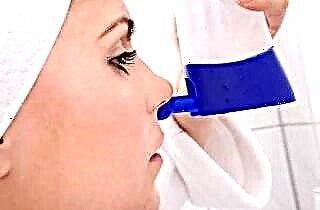Unilateral or bilateral catarrhal sinusitis is the initial stage of inflammation of the mucous membrane of the paranasal sinuses. It is always accompanied by swelling, redness and plethora of the mucous membrane with abundant secretion of mucus from the nasal passages. Puffiness disrupts the normal process of secretion evacuation, as a result of which its stagnation occurs. For this reason, right-sided or left-sided catarrhal sinusitis is quite often complicated by a bacterial infection that concentrates in the affected cavity.
It is quite simple to treat catarrhal sinusitis, it is much more difficult to start therapy on time. If you let the disease take its course, there is a high probability of a rapid transition from the initial catarrhal form to the purulent stage. In addition, in the absence of medical care, such an ailment is instantly transformed into a chronic form, which further complicates the treatment.
Symptoms and causes of the onset of the disease
 As clinical practice shows, acute edematous catarrhal sinusitis most often occurs in the autumn-winter period, when the body's immune forces are significantly weakened. It is difficult to accurately establish the presence of such a disease without the help of a doctor, since the first signs of sinusitis are in many ways similar to the manifestations of seasonal flu, colds and rhinitis (rhinitis).
As clinical practice shows, acute edematous catarrhal sinusitis most often occurs in the autumn-winter period, when the body's immune forces are significantly weakened. It is difficult to accurately establish the presence of such a disease without the help of a doctor, since the first signs of sinusitis are in many ways similar to the manifestations of seasonal flu, colds and rhinitis (rhinitis).
In some cases, mucosal edema is diagnosed against the background of allergic reactions, diphtheria or measles. Less often, allergy to cold becomes the key cause of sinusitis. One of the main factors provoking the disease is a violation of nasal breathing due to:
- congenital defects in the structure of the nose;
- ENT diseases;
- mechanical effects on the nose (blows, bruises, and so on).
Pharyngitis and adenoids also contribute to an increased risk of sinusitis. A characteristic symptom of such a disease is a sharp deterioration in health after temporary relief from a cold.
It may seem to the patient that he has coped with the common cold. However, his health deteriorates very quickly. Severe nasal congestion appears, body temperature rises.
Catarrhal sinusitis is accompanied by the following manifestations:
- discomfort in the nose;
- impossibility of nasal breathing;
- deterioration in general health;
- fatigue even after minor exertion;
- apathy, lethargy, irritability;
- severe runny nose;
- profuse discharge from the nostrils;
- high temperature;
- signs of intoxication - chills, body aches, muscle pain, and so on.
Catarrhal sinusitis, the symptoms of which are quite varied, manifests itself very quickly. All of the above signs are detected already after 24-48 hours from the moment the irritant factor is exposed to the body.
Disease types
 The inflammatory process can affect one or two sinuses (sinuses). Therefore, sinusitis is divided into one-sided and two-sided. In the first case, redness, inflammation and swelling of the mucous membrane are observed in one of the maxillary sinuses. On the same side, the nasal canal will be completely blocked and breathing will be impaired. In a horizontal position, the patient has a lot of mucus from the stuffy nostril.
The inflammatory process can affect one or two sinuses (sinuses). Therefore, sinusitis is divided into one-sided and two-sided. In the first case, redness, inflammation and swelling of the mucous membrane are observed in one of the maxillary sinuses. On the same side, the nasal canal will be completely blocked and breathing will be impaired. In a horizontal position, the patient has a lot of mucus from the stuffy nostril.
As for the bilateral type of sinusitis, it assumes a symmetrical course of the disease. This means that the patient's nasal passages are blocked on both sides, and a secret is released simultaneously from two nostrils.
When palpating (palpating) the outer side of the maxillary sinuses, discomfort and painful sensations of varying intensity appear. In addition, swelling and redness of the facial skin and lower eyelids is clearly visible. Pain and lacrimation are worse when the head is tilted.
To quickly and accurately get rid of any of the above forms of sinusitis, you must immediately consult a doctor. He will be able to identify the root cause of the disease. The ENT will select the optimal drugs, taking into account the individual characteristics of the patient, the form of sinusitis and the place of concentration of the inflammatory process.
Therapy
If you do not delay treatment, then unilateral or bilateral catarrhal sinusitis is eliminated quickly and easily. What procedures and means are used for this?
 Look for medications to narrow blood vessels. Drops and sprays allow you to cope with the swelling of the mucous membrane. The following anticongestants are the most effective: "Ephedrine", "Naphazoline", "Oxymetazoline" and some others.
Look for medications to narrow blood vessels. Drops and sprays allow you to cope with the swelling of the mucous membrane. The following anticongestants are the most effective: "Ephedrine", "Naphazoline", "Oxymetazoline" and some others.- Regular rinsing of the nose with antiseptic solutions would be a good addition. They will help reduce the intensity of the inflammatory process and the risk of foci of pathogenic microbes. For these purposes, use "Miramistin" and "Furacilin". Alternatively, decoctions of St. John's wort, chamomile, calendula, or rinses based on saline solutions are used. At least three washes should be performed per day.
- Do not forget about inhalation - a time-tested way to get rid of sinusitis at an early stage. Steam inhalations based on boiled potatoes have proven themselves very well. If desired, it can be replaced with essential oils of medicinal plants (mint, eucalyptus, lavender, pine, fir, and so on). A liter of boiling water will require no more than 10 drops of oil.
- Homemade nasal drops. Carefully cut the bottom two leaves off the aloe and put them in the refrigerator for 5 hours. Then peel them (remove the peel), chop finely and squeeze out the precious juice with a cloth or gauze. A patient who suffers from sinusitis needs to drip into the nose from 3 to 5 drops every day, three times a day. Such a remedy improves local immunity well, has an antiviral and anti-inflammatory effect.
- Use aerosol and spray topical antibacterials. When irrigated, they fall exactly on the affected areas of the mucous membrane and reduce the risk of complications. Doctors advise using "Bioparox", "Isofra", "Polydex" and so on.
Prophylaxis
 We all know that any disease is always easier to prevent than to cure later. This also applies to catarrhal sinusitis. To minimize the risk of contracting this condition, we advise you to always dress for the season. It is especially important to wear a hat to protect your head from the cold.
We all know that any disease is always easier to prevent than to cure later. This also applies to catarrhal sinusitis. To minimize the risk of contracting this condition, we advise you to always dress for the season. It is especially important to wear a hat to protect your head from the cold.
Always treat seasonal illnesses (colds, rhinitis), no matter how insignificant they may seem. Believe me, it is better to spend time and cure a common cold than to forget about it and then fight the acute inflammatory process in the maxillary sinuses.
Also, remember to see your doctor regularly. It is quite enough to appear at the otolaryngologist every 6 months.
Make sure that the air in the room always corresponds to the optimal level of humidity (this is especially true for the winter period). Damp mop regularly or buy an automatic humidifier. If this is not done, the mucous membrane becomes unnecessarily dry and fragile. Local immunity decreases, and pathogenic microflora develops faster in the nasal cavity.
Monitor your health, lead an active lifestyle, listen to your body. He will always tell you what he needs. Breathe deeply and be healthy!

 Look for medications to narrow blood vessels. Drops and sprays allow you to cope with the swelling of the mucous membrane. The following anticongestants are the most effective: "Ephedrine", "Naphazoline", "Oxymetazoline" and some others.
Look for medications to narrow blood vessels. Drops and sprays allow you to cope with the swelling of the mucous membrane. The following anticongestants are the most effective: "Ephedrine", "Naphazoline", "Oxymetazoline" and some others.

